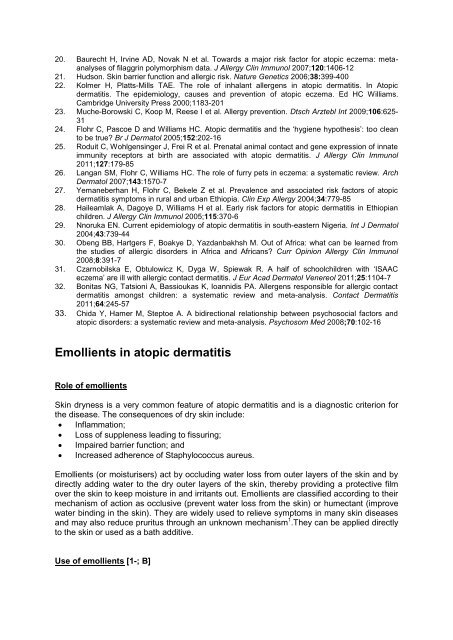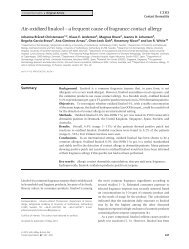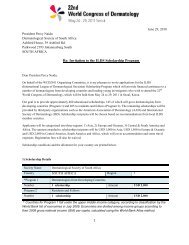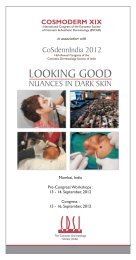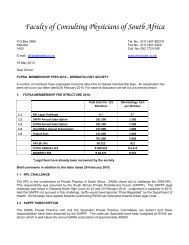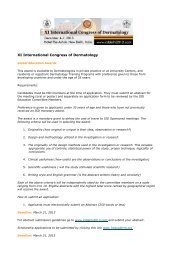Guidelines on the Management of Atopic Dermatitis ... - Dermatology
Guidelines on the Management of Atopic Dermatitis ... - Dermatology
Guidelines on the Management of Atopic Dermatitis ... - Dermatology
You also want an ePaper? Increase the reach of your titles
YUMPU automatically turns print PDFs into web optimized ePapers that Google loves.
20. Baurecht H, Irvine AD, Novak N et al. Towards a major risk factor for atopic eczema: metaanalyses<br />
<strong>of</strong> filaggrin polymorphism data. J Allergy Clin Immunol 2007;120:1406-12<br />
21. Huds<strong>on</strong>. Skin barrier functi<strong>on</strong> and allergic risk. Nature Genetics 2006;38:399-400<br />
22. Kolmer H, Platts-Mills TAE. The role <strong>of</strong> inhalant allergens in atopic dermatitis. In <strong>Atopic</strong><br />
dermatitis. The epidemiology, causes and preventi<strong>on</strong> <strong>of</strong> atopic eczema. Ed HC Williams.<br />
Cambridge University Press 2000;1183-201<br />
23. Muche-Borowski C, Koop M, Reese I et al. Allergy preventi<strong>on</strong>. Dtsch Arztebl Int 2009;106:625-<br />
31<br />
24. Flohr C, Pascoe D and Williams HC. <strong>Atopic</strong> dermatitis and <strong>the</strong> „hygiene hypo<strong>the</strong>sis‟: too clean<br />
to be true? Br J Dermatol 2005;152:202-16<br />
25. Roduit C, Wohlgensinger J, Frei R et al. Prenatal animal c<strong>on</strong>tact and gene expressi<strong>on</strong> <strong>of</strong> innate<br />
immunity receptors at birth are associated with atopic dermatitis. J Allergy Clin Immunol<br />
2011;127:179-85<br />
26. Langan SM, Flohr C, Williams HC. The role <strong>of</strong> furry pets in eczema: a systematic review. Arch<br />
Dermatol 2007;143:1570-7<br />
27. Yemaneberhan H, Flohr C, Bekele Z et al. Prevalence and associated risk factors <strong>of</strong> atopic<br />
dermatitis symptoms in rural and urban Ethiopia. Clin Exp Allergy 2004;34:779-85<br />
28. Haileamlak A, Dagoye D, Williams H et al. Early risk factors for atopic dermatitis in Ethiopian<br />
children. J Allergy Clin Immunol 2005;115:370-6<br />
29. Nnoruka EN. Current epidemiology <strong>of</strong> atopic dermatitis in south-eastern Nigeria. Int J Dermatol<br />
2004;43:739-44<br />
30. Obeng BB, Hartgers F, Boakye D, Yazdanbakhsh M. Out <strong>of</strong> Africa: what can be learned from<br />
<strong>the</strong> studies <strong>of</strong> allergic disorders in Africa and Africans? Curr Opini<strong>on</strong> Allergy Clin Immunol<br />
2008;8:391-7<br />
31. Czarnobilska E, Obtulowicz K, Dyga W, Spiewak R. A half <strong>of</strong> schoolchildren with „ISAAC<br />
eczema‟ are ill with allergic c<strong>on</strong>tact dermatitis. J Eur Acad Dermatol Venereol 2011;25:1104-7<br />
32. B<strong>on</strong>itas NG, Tatsi<strong>on</strong>i A, Bassioukas K, Ioannidis PA. Allergens resp<strong>on</strong>sible for allergic c<strong>on</strong>tact<br />
dermatitis am<strong>on</strong>gst children: a systematic review and meta-analysis. C<strong>on</strong>tact <strong>Dermatitis</strong><br />
2011;64:245-57<br />
33. Chida Y, Hamer M, Steptoe A. A bidirecti<strong>on</strong>al relati<strong>on</strong>ship between psychosocial factors and<br />
atopic disorders: a systematic review and meta-analysis. Psychosom Med 2008;70:102-16<br />
Emollients in atopic dermatitis<br />
Role <strong>of</strong> emollients<br />
Skin dryness is a very comm<strong>on</strong> feature <strong>of</strong> atopic dermatitis and is a diagnostic criteri<strong>on</strong> for<br />
<strong>the</strong> disease. The c<strong>on</strong>sequences <strong>of</strong> dry skin include:<br />
Inflammati<strong>on</strong>;<br />
Loss <strong>of</strong> suppleness leading to fissuring;<br />
Impaired barrier functi<strong>on</strong>; and<br />
Increased adherence <strong>of</strong> Staphylococcus aureus.<br />
Emollients (or moisturisers) act by occluding water loss from outer layers <strong>of</strong> <strong>the</strong> skin and by<br />
directly adding water to <strong>the</strong> dry outer layers <strong>of</strong> <strong>the</strong> skin, <strong>the</strong>reby providing a protective film<br />
over <strong>the</strong> skin to keep moisture in and irritants out. Emollients are classified according to <strong>the</strong>ir<br />
mechanism <strong>of</strong> acti<strong>on</strong> as occlusive (prevent water loss from <strong>the</strong> skin) or humectant (improve<br />
water binding in <strong>the</strong> skin). They are widely used to relieve symptoms in many skin diseases<br />
and may also reduce pruritus through an unknown mechanism 1 .They can be applied directly<br />
to <strong>the</strong> skin or used as a bath additive.<br />
Use <strong>of</strong> emollients [1-; B]


